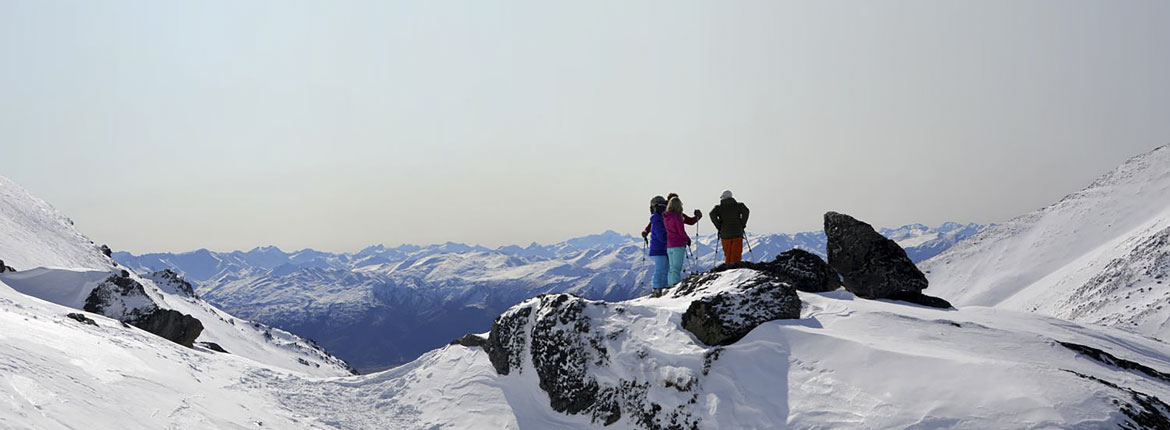We laid our clothes out carefully the night before our much-anticipated snowshoeing expedition to The Remarkables.
Layers of merino wool, with waterproof, windproof pants and jackets, tramping boots, double thickness polar fleece neck warmers, goggles, sunglasses, beanies, mittens, sunblock and a few extra layers just in case we got stranded on the mountain.
The forecast was ambiguous, suggesting the possibility of four seasons in one day. Mist hung over the tops of the jagged peaks enhancing their moody mystique.
Knowing how conditions can change dramatically in the mountains, we left nothing to chance.
Our guide Shaun nodded his approval of our superb state of preparedness when he collected us from the lakefront Crowne Plaza Hotel in Queenstown bright and early next morning. We purred under his praise.
When we went to collect the other two members of our party, a couple of young Australians, we thought there must have been some mistake. Wrong place, wrong couple or maybe the pair had decided against the trip and were heading to the gym instead. They were waiting in the car park, hatless, gloveless, wearing shorts, cotton T-shirts and flimsy sandshoes. All credit to our veteran guide; Shaun didn't even flinch, not so much as a tightened neck muscle. He had seen it all before and had the situation totally under control. Out came the full kit of back-up gear from boots and jackets to beanies and gloves. We saved the ribbing until we got to know them a bit.
The beauty of snowshoes is they provide practical, easy, stable, safe access to snow-covered mountains that are normally the domain of skiers, snowboarders and climbers.
As skiers of many years, we take for granted our right to commune with mountain tops and view spectacular landscapes from lofty heights. 
But our Aussie friends had never been near snow before, nor had they ever driven up mountain roads, so they were wide-eyed with wonder. Mastering the skills required for snowshoeing took all of 20 seconds. Grab a set of snowshoes, fasten them to any sized boot with the stretchy rubber straps, click the raised-heel option into place if there’s a climb ahead – "your calf muscles will love this nifty device", Shaun says – grasp a pair of height-adjustable hiking poles which allow the forearm to be at right angles to the body, and head on up the mountain. If you can walk, you can snowshoe, as the brochure says, and it’s absolutely true.
Traversing demands a slightly different technique, involving the rolling of the ankle to flatten the snowshoe on the surface of the snow and allow the spikes to dig into the snow. As a skier programmed for decades to edge into the snow, it felt a bit unnatural at first but was highly effective in eliminating any slip factor.
After 40 minutes of easy but steady climbing, we left the ski field behind and reached the startling white wilderness of Laka Alta, nestled in a glacially-scoured cirque below the black crags of the range.
I gazed up at the deeply furrowed face, gouged and scarred by the mighty glaciers that had shaped the landscape over the past two million years. It felt quite surreal to sit there on a ledge just below the summit, eating lunch.
On the way down the view of the Wakatipu Basin enclosed in a necklace of mountains was magnificent. I was astonished at the scope of the panorama: Lake Wakatipu, Lake Hayes, Queenstown, Frankton, Arrowtown, the Kawarau River, the Shotover River, Mt Earnslaw, Coronet Peak, Ben Lomond, the Crown Range, planes taking off and landing at the airport, rainbow-coloured paragliders sailing by, a flash of bright red from the plumage of a kea . . .
After six and a half exhilarating hours of healthy, hearty activity, we returned to civilisation. A mulled wine and a hot bath were top of my agenda. I don't think I've ever slept quite so soundly as I did that night; I bet our Aussie mates slept well too. It must be that sweet mountain air.
Reported by Justine Tyerman for our AA Directions, Winter 2016 issue




